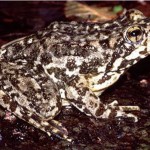You don’t have to be a biologist to assume that California’s epic drought is affecting water-loving critters. Frogs and amphibians lazing and splashing around mountain streams and pools are harder to find these days – especially for those endangered ones like the rare mountain yellow-legs frogs which are on both state and federal lists.
A recent survey of mountain yellow-leggers revealed that, yes, indeed these hoppers were showing signs of stress because of the dry conditions up in the San Jacinto Mountains, near Palm Springs. Researchers were checking the frogs which were originally hatched at the San Diego Zoo Institute for Conservation Research and the Los Angeles Zoo. “The drought is adding an additional challenge to their survival, but we are still finding a significant number of frogs that are healthy and growing,” says Frank Santana, a research coordinator for the Institute.
Of the 300 tadpoles that were released, researchers believe about 25 percent continue to survive.
“Every frog counts,” confirms Ian Recchio, curator of reptiles and amphibians at the Los Angeles Zoo that has participated in the program to repopulate the mountain yellow-legged frog for the last five years. Other partners in the recovery program include: the U.S. Forest Service, U.S. Geological Survey, California Department of Fish and Wildlife, and U.S. Fish and Wildlife Service.
Once plentiful, the yellow-hued hoppers now number about 200 in the San Gabriel, San Bernardino and San Jacinto Mountains. The natural habitat destruction, the introduction of the hungry “Eat Anything” bullfrog and the drought is causing a “perfect storm of problems for the yellow-legged frog,” he says.
There is talk to expand the program to other locations in the Southland, continues Recchio. “We are looking at areas of the Los Angeles Forest and the San Gabriel Mountains for new populations to add to our breeding programs,” he says. Currently a small BioScience Facility at the LA Zoo has been raising tadpoles and froglets for the past five years. (It’s off limits to guests and visitors.)
No doubt amphibian biologists will be doing their own version of a rain dance for a wet winter in SoCal. But Recchio points out that if zoos “hadn’t stepped in with these programs about 10 years ago, there might not be any frogs at all in the mountains. We have to keep moving forward.”

